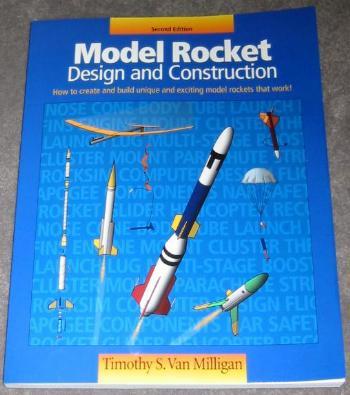Model Rocket Design and Construction (Book by Tim Van Milligan) Book/Magazine
Apogee Components - Model Rocket Design and Construction {Book}
Contributed by Clive Davis
| Overall Rating: | starstarstarstarstar_border |
| Author: | Tim Van Milligan |
| Manufacturer: | Apogee Components  |
 Review:
Review:
A soft cover book details how to design and construct model rockets. It is fiiled with numerous illustrative drawings and photos. 20 chapters plus an appendix. Price: $23.95 (as of January, 2003).
160 pages. The book includes a demo version of RockSim on CD-ROM. Book covers such topics as construction techniques, repair techniques, painting, designing gliders, helicopters, scale models, payloads and clusters. It also includes some useful checklists and an extensive glossary.
This is a good introduction to anyone who is interested in designing and flying their own creations. Tim Van Milligan covers a wide range of materials including unique methods of recovery. I had never heard of horizontal-spin recovery. Tim also goes into quite a bit of detail discussing both helicopter and glider recovery. The book discusses fin shape and placement, including the discussion of built-up fins. There are suggestions for creating ones own nose cones and a section on the use of paper boattails and transitions.
The book often advertises Apogee products (such as the mini engines and RockSim), but for the most part, the information is helpful. At times, I ran across terms and calculations that were unfamiliar to me (I am coming from a non-technical, non-engineering background), but I think that the book still reads well even if not every single concept is understood.
If I had to buy just one book for the beginning rocketeer, I would still recommend Harry Stine's Handbook on Model Rocketry. If I was recommending a book on the plethora of buildling, designing and flying techniques, I would recommend Tim Van Milligan's book. The book is published by Apogee Components and features annoying little typographical errors. However, the illustrations and photos are very helpful, and the chapters flow in a logical manner.
Overall Rating: 4 out of 5
Other Reviews
- Model Rocket Design and Construction (Book by Tim Van Milligan) By Dick Stafford (January 7, 2009)
Summary: The 3rd edition of Timothy Van Milligan’s Model Rocket Design and Construction contains 328 pages of rocketry goodness covering everything from planning and design through recovery. This edition is twice the size of the previous and includes an impressive array of facts, techniques and concepts about all facets of the hobby. Much of the material Tim has added in this edition ...
- Model Rocket Design and Construction (Book by Tim Van Milligan) By Nick Esselman (December 13, 2008)
The third edition of Timothy S. Van Millian's (Apogee Components owner) "Model Rocket Design and Construction" book has been released. I dare venture to say that this edition should be considered the new primary reference and teaching publication for rocketry. I know that most will point to the "Handbook of Model Rocketry" which was written by one of the founders of model rocketry, G. Harry ...
 |
 |
S.T.M. (June 10, 2003)
Sponsored Ads
 |
 |




![Rocket And Space Corporation Energia: Apogee Books Space Series 17 [ ] Used Rocket And Space Corporation Energia: Apogee Books Space Series 17 [ ] Used](https://i.ebayimg.com/images/g/AtQAAOSwjoFZrDUu/s-l225.jpg)







D.K. (October 1, 2000)